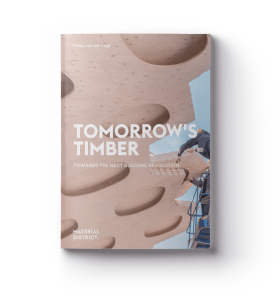 The world is rediscovering timber. Thanks to new technologies that open up new constructive techniques; and to a better appreciation of sustainability.
The world is rediscovering timber. Thanks to new technologies that open up new constructive techniques; and to a better appreciation of sustainability.
MaterialDistrict, a Dutch foundation, has published Tomorrow’s timber, a book that explores all aspects of building with it, from GHG emissions and fire resistance to design and costs. This is the first of two articles.
Timber myths dispelled
The book opens with a clarion call. It dispels four ‘timber myths: prejudices about building in timber that lead to unfounded misconceptions.’ They hamper its mass adoption.
1. A timber building is not safe in case of fire. Not true, if the building is properly designed. For instance, impregnation with a fire retardant will greatly enhance the building’s ability to withstand a fire. Architects may mount overdimensioned beams that in case of fire will char on the outside without losing their structural properties. Timber beams are less likely to collapse in case of a fire than steel beams. Architects can partition the building in order to contain any fire outbreak for some time. They will use sprinklers. Timber buildings can be designed in such a way that they conform to all fire regulations.
2. A timber building will not last very long due to low durability. Not true, if the material is kept dry. The oldest timber building in the world dates back to 782 AD, the Nanchen Temple in China. Indoor applications can last very long indeed. For outdoor applications, such as cladding and window frames, wood modification technologies have been developed. The resulting structures are highly resistant to biological attacks and can even outperform buildings made from bricks, concrete or steel.
3. A timber building is more expensive than conventional building structures. Yes, material costs are higher for such a building. But timber allows for innovation in construction technology. It even requires such an innovation. ‘If designed and coordinated well, building in mass timber will actually yield better quality, health and safety at a competitive price level.’ The material requires good planning, much prefabrication and preferably just-in-time construction. Those conditions fulfilled, this material may well be the most competitive option. And don’t forget the building’s sustainability and its effects on human wellbeing!
4. There are not enough forests available in Europe to mass adopt timber as main construction material. Not true. Over the past century, Europe has done a good job in reforestation and sustainable forest management. At present, forests cover 37% of European land area; and there is room for further reforestation. Europe would have to reduce wood use for bioenergy production and increase cascading. Then, every European citizen could potentially live in a timber house or apartment by the end of this century.

Sustainability
And then, timber buildings are much more sustainable than their abiotic counterparts. Timber as a construction material does not deplete the earth’s resources. The material used will grow back several times during the lifetime of a properly designed building. It is perfectly biodegradable – and the building’s material may be reused in other applications after disassembly. Then, it will become not just part of a biobased but also of a circular economy. The building industry may even become an active tool in the containment of climate change. Because of the carbon stored in buildings. And more importantly in the prevention of the production of cement and concrete; these are responsible for a stunning 10% of all man-made greenhouse gas emissions (and increasing).
Many of timber’s achievements result from innovations. Wooden beams aren’t simply cut from a tree any more. All structural elements are engineered. This greatly improves the material’s properties. The new technologies allow for very large spans and innovative architectural design. We will look into these technologies in a second article.
Author
Diederik van der Hoeven
Source
Supplier
Share
Renewable Carbon News – Daily Newsletter
Subscribe to our daily email newsletter – the world's leading newsletter on renewable materials and chemicals












